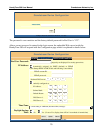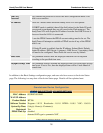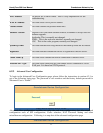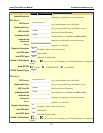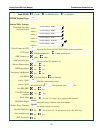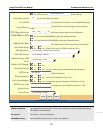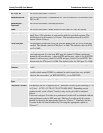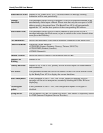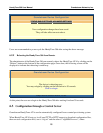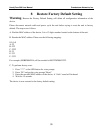
HandyTone-386 User Manual Grandstream Networks, Inc.
23
User ID is Phone
Number
If the HandyTone ATA has an assigned PSTN telephone number, this field
should be set to “Yes”. Otherwise, set it to “No”. If “Yes” is set, a
“user=phone” parameter will be attached to the “From” header in SIP request
Early Dial
Default is No. Use only if proxy supports 484 response
Dial Plan Prefix
Sets the prefix added to each dialed number
No Key Entry
Timeout
Default is 4 seconds.
Use # as
Send Key
This parameter allows users to configure the “#” key to be used as the “Send”
(or “Dial”) key. If set to “Yes”, pressing this key will immediately trigger the
sending of dialed string collected so far. In this case, this key is essentially
equivalent to the “(Re)Dial” key. If set to “No”, this “#” key will then be
included as part of the dial string to be sent out.
Use Random Port
This parameter, when set to Yes, will force random generation of both the local
SIP and RTP ports. This is usually necessary when multiple HandyTone ATAs
are behind the same NAT.
NAT Traversal
This parameter defines whether the HandyTone ATA NAT traversal
mechanism will be activated or not. If activated (by choosing “Yes”) and a
STUN server is also specified, then the HandyTone ATA will behave according
to the STUN client specification. Under this mode, the embedded STUN client
inside the HandyTone ATA will attempt to detect if and what type of
firewall/NAT it is sitting behind through communication with the specified
STUN server. If the detected NAT is a Full Cone, Restricted Cone, or a Port-
Restricted Cone, the HandyTone ATA will attempt to use its mapped public IP
address and port in all its SIP and SDP messages. If the NAT Traversal field is
set to “Yes” with no specified STUN server, the HandyTone ATA will
periodically (every 20 seconds or so) send a blank UDP packet (with no
payload data) to the SIP server to keep the “hole” on the NAT open.
Keep-alive interval
This parameter specifies how often the HandyTone ATA sends a blank UDP
packet to the SIP server in order to keep the “hole” on the NAT open.
Use NAT IP:
NAT IP address used in SIP/SDP message. Default is blank.
Proxy-Require
SIP Extension to notify SIP server that the unit is behind the NAT/Firewall.
TFTP Upgrade
Server
This is the IP address of the configured TFTP server. If it is non-zero or not
blank, the HandyTone ATA will attempt to retrieve new configuration file or
new code image from the specified TFTP server at boot time. It will make up to
3 attempts before timeout and then it will start the boot process using the
existing code image in the Flash memory. If a TFTP server is configured and a
new code image is retrieved, the new downloaded image will be verified and
then saved into the Flash memory.



